 .:: False Identity ::. .:: False Identity ::.
|
Disclaimer: The information provided here is for educational purposes only for those who check and design identification cards. Modifying a state document (driver license) is a criminal offense, as well as underage drinking and tobacco usage. The driver license used in the demonstration was restored afterwards.
After many years of planning and improved design AAMVA has set many standards for driver license design. The security features used in today's NY State license are top of the line and incorporate two different types of bar codes, ultraviolet water marks, super fine detail printing, multiple date of birth values printed on the front and lots of other features. In today's world many underage drinkers must acquire a fake ID or a chalked ID in order to purchase alcohol or tobacco products. Most fake ID's used are out of state ID which fool the cashier since they are not aware of the out-of-state driver license security features. A lot of times people avoid using a fake NY State license in NY because of the difficulties involved in making a fake. At most gas stations the cashier is instructed to scan the bar code of the ID and match the digital information with the data on the front.

This is the front side of a driver's license. Under UV light a shield can be seen in the middle of the license if it is the new edition. To the touch the surface feels somewhat like Teflon and has an erie luster when viewed under the sun at certain angles. This license indicates that the driver is under the age of 21 with the use of red ink for the driver ID number and the date of birth.
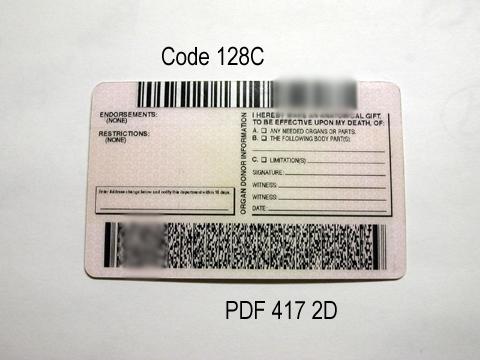
On the back side of the card two bar codes of different formats can be seen. The one that looks like a regular barcode used in stores is actually in "Code 128C" format and the 2D bar code which stores lots of personal information is in what is called the "PDF417" format. Usually gas stations scan the Code 128C bar code to verify age and expiration date. The raw data on the bar code consists of the nine digit driver's ID number, the date of birth (mmddyy) and the expiration year (yy). For some awkward reason (possibly for security reasons) the bar code format switches from Code 128C to Code 128B at the end. a Sample barcode may look like this after decoding, "12345678910288004". In this data the driver ID number is 123456789, the date of birth is 10/28/1980 and the expiration year is 2004.
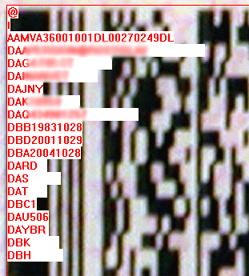
This is the data stored within the PDF417 barcode. The data is stored in fields with three letter designators for each data field. For example the drivers name would be indicated by the designator DAA and their driver license class is DAR. In the example above the license is a class D (regular driver) so you can see a DARD within the data. Many fields are optional from state to state and even finger print data can be stored on the barcode.
 AAMVA Data Sheet where more info on the 2D barcode can be found (PDF) AAMVA Data Sheet where more info on the 2D barcode can be found (PDF)

This is a PDF417 2D barcode with the text "Voltage Labs by Rostislav Persion" encoded into it. Any data can be encoded into this barcode as well as false information such as date of birth.
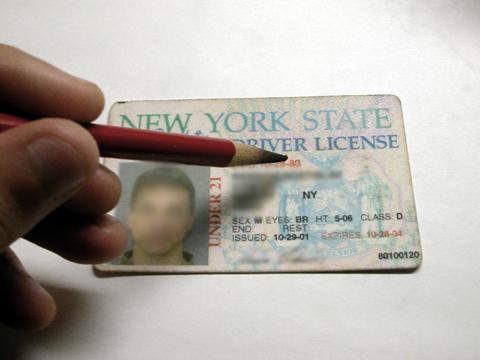
Chalking is a well know technique among those modifying their ID. It is a process where one modifies the visual appearance of the document making the date of birth appear different than originally intended by DMV. Some people use white out for this but sharp color pencils are the preferred tool. In the above image a chalking technique is demonstrated. Notice how effective the change is.
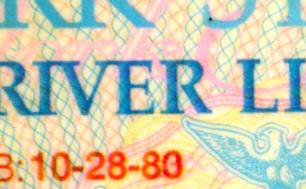
The 83 was quickly modified to display 80. A regular trained cashier would not notice such a modification. If asked about the "Under 21" warning printed on the license a typical response would be somewhat similar to this, "My new license has not arrived yet and this is the only one I have."

Some cashiers are trained to check the date of birth and then match the year with the first two digits of the numbers in the bottom right corner. If the numbers do not match then the ID is an obvious fake. A good chalked ID should take this into account as well as the main date of birth.
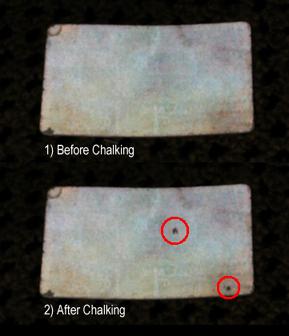
Skilled chalking can make any ID seem flawless but there is one security feature which most people do not take into account. This feature is the special property of the license which causes it to reflect UV. After marking on the surface with any kind of pencil or white-out, that spot absorbs UV light. In the above image a license is exposed to pulsed high-power UV. The ID is then chalked and once again exposed to UV. In the second photo you can see black spots on the license where the UV doesn't reflect. Usually silver lip gloss can be applied in a thin coating to defeat this. Though this may seem like a minor detail do consider the fact that places such as night clubs and bars are abundant with black lights, which are emitting UV light and may expose the flaw.

Because most gas stations and convenient food stores scan the Code 128C barcode one should be generated, printed out and mounted over the original, thus digitally defeating the security feature. Damaging the original barcode works as well. When the card does not scan properly the cashier cannot use this security feature and is forced to rely on the visual information.
|
 |
|



